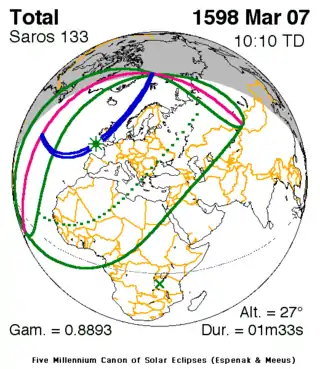Solar eclipse of March 7, 1598
A total solar eclipse occurred on March 7, 1598 (25 February 1597 using the Old Style date). A solar eclipse occurs when the Moon passes between Earth and the Sun, thereby totally or partly obscuring the image of the Sun for a viewer on Earth. A total solar eclipse occurs when the Moon's apparent diameter is larger than the Sun's, blocking all direct sunlight, turning day into darkness. Totality occurs in a narrow path across Earth's surface, with the partial solar eclipse visible over a surrounding region thousands of kilometres wide.
| Solar eclipse of March 7, 1598 | |
|---|---|
 Map | |
| Type of eclipse | |
| Nature | Total |
| Gamma | 0.8893 |
| Magnitude | 1.0214 |
| Maximum eclipse | |
| Duration | 93 sec (1 m 33 s) |
| Coordinates | 47.7°N 8.2°W |
| Max. width of band | 156 km (97 mi) |
| Times (UTC) | |
| Greatest eclipse | 10:10:01 |
| References | |
| Saros | 133 (22 of 72) |
| Catalog # (SE5000) | 8536 |
Visibility
Totality was visible in the United Kingdom with a diagonal track from Cornwall in the south-west to Aberdeen in the north-east of Scotland.
It was observed from Germany by Tycho Brahe.[1]
Related eclipses
It is a part of solar Saros 133.
This is the 22nd member of Solar Saros 133. The previous event was on February 15, 1580 (21st member). The next event would be on March 17, 1616 (23rd member).
References
- Monthly Notices of the Royal Astronomical Society, Volume 54; Volumes 1893–1894 J. L. E. Dreyer, 1894, p.439 Note on the solar eclipse of 1598
- Illuminating Eclipses: Astronomy and Chronology in King Lear Hanno Wember, Figure 2: Solar Eclipse, March 7, 1598 zone of totality cuts through central England.
- Total Solar Eclipse of 1598 Mar 07 Fred Espenak
- Total Eclipse of the Sun: 1598 March 07 Archived 2017-04-10 at the Wayback Machine
- NASA chart graphics
- Googlemap
- NASA Besselian elements
- George J. Walker (1869). A List of Anniversaries of Ramrkable Astronomical Discoveries and Occurrences. p. 111.
.jpg.webp)

